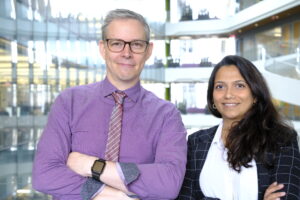 Scientist Leigh Plant considers himself “green” when it comes to entrepreneurship, though he has spent the past 20 years studying ion channels and their role in human pathology.
Scientist Leigh Plant considers himself “green” when it comes to entrepreneurship, though he has spent the past 20 years studying ion channels and their role in human pathology.
“I’m still getting used to the label of entrepreneur, but I’m on the path hopefully,” said Plant, PhD and Assistant Professor of Pharmaceutical Sciences at Northeastern.
In the summer of 2023, Plant’s lab landed funding from the Spark Fund, an innovative program Northeastern’s Center for Research Innovation (CRI) offers to faculty innovators.
“Coming into the Spark Fund, we identified a potential mechanism, which required us to develop some new techniques in the lab to study the sodium channel that underlies the problem in skeletal muscle,” Plant noted.
He said it took his team several years to develop and test these tools to determine their potential.
“With Spark Fund, our objective is to leverage the basic science knowledge that we’ve accumulated, and to move forward and use this information to identify small molecule drugs that could act to offset the disease problem,” Plant said.
How Will CRI’s Spark Fund Help?
Plant is especially interested right now in finding mentors with Artificial Intelligence, AI, knowledge who can help with the strategy of a virtual drug screening for his company. He believes the Spark Fund’s connections will help him to facilitate these relationships.
“A virtual drug screening is where you test, once you’ve identified what you think a drug binding site would be. You can use computation and AI to screen millions or even billions of potential molecules that might interact with the protein machinery of that particular site,” he said.
One takeaway he’s learned so far during his time in the Spark Fund program he hopes fellow entrepreneurs will benefit from hearing: you must communicate your science to people who can help take it to the next level.
“Too many people often hold their cards close to their chest because of the culture,” Plant noted.
The Spark Fund also helped Plant find resources and relationships to leverage that he did not know existed at Northeastern CRI. “It’s really excellent the university has this infrastructure and opportunity to develop ideas and support scientists that recognize some of their work might be advantageous to patients,” he remarked.
Paving the Way for Aspiring Female Scientists
Kirin Gada, who earned her PhD at Northeastern, works in Plant’s lab. “It’s so rare to have a PI (principal investigator) who wants to give you credit, especially being a woman in science and tech, so I’m really grateful to Leigh for that,” she noted.
Gada spoke of the passion Plant brings to his lab. She said his enthusiasm deeply resonates with her, inspiring her to reach her highest potential as a fellow scientist. She said she considers herself “super lucky” to be a member of Plant’s team, particularly when she has the chance to observe Leigh in action in his lab.
For Gada, the Spark Fund has been a “huge change” she’s grateful for.
She still recalls the “eureka moment” when she and Leigh realized they had the beginning of a business. “In one year, we go oh we have an idea, to oh it got funded, to oh we might have a startup, to now we’re applying for a patent.” In the future, Gada hopes Spark Fund can help point her team in the right direction when it comes time to form a board.
The Science Breakdown
According to Plant, proteins form machines in the membranes of cells that control how ions move in and out of these cells. The electrical signals they create allow cells to communicate with each other at high speed, an excitability that sends signals to the nervous system, heart, and muscle.
These proteins are highly regulated, which is necessary so that they can give the body what it needs, but if something goes wrong the cells reveal a disease state. Plant’s research has been focusing on skeletal muscles caused by mutations in sodium ion channels cells. He’s examining what occurs when these ions misbehave, which causes debilitating muscle weakness or contraction. There is no cure for this type of disorder, which is within the broader family of muscular dystrophy (MD) disorders. Current treatments cause adverse side effects and genetic manipulations have been unsuccessful so far. The ultimate goal of Plant’s work is to find small molecule drugs that could be beneficial for patients with a rare MD disorder that impacts less than 1 in 100,000 people.
Written by Joanna Smiley
